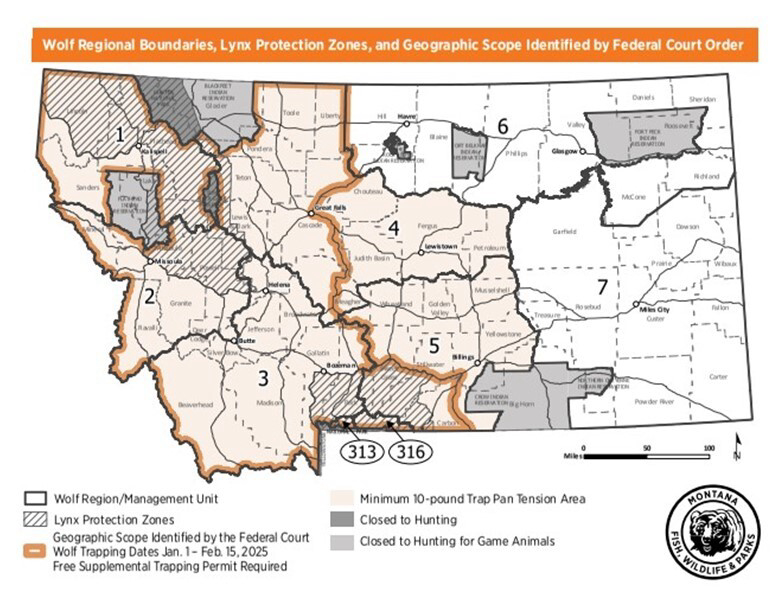
|
Trapping season gets into full swing on Dec. 1 with the opening of bobcat, marten, and fisher seasons. Trapping for water-based species, like beaver, mink, muskrat and otters opened Nov. 1.
Wolf trapping also opens in part of Montana Dec. 2, except in areas where the harvest quotas have been met for the season. However, within a geographic area defined by a federal court order (see map), which covers all of western Montana, wolf trapping will be open Jan. 1 through Feb. 15, although quotas will also influence closures in these areas. Please see the 2024 Wolf and Furbearer Regulations for specific details.
Trapping in the geographic area defined by a federal court order
Within this geographic area defined by a court order, trappers who are targeting nongame species, (raccoon, badger, red fox) and predators (coyotes, skunks, weasels) must have a Free Supplemental Trapping Permit, even if you already have a trapping license.
Trappers who are targeting predators and nongame species for the purposes of livestock protection within this geographic area defined by a court order must have the Free Supplemental Trapping Permit and a completed and signed declaration which states the producer’s name, that the producer has provided permission for the trapping and the county where the trapping is occurring. This declaration form can be downloaded when you get your Free Supplemental Trapping Permit. This declaration is not needed for producers that are trapping for livestock protection on their own lands or lands that they have leased.
If you're interested in trapping wolves in Montana, please take time to understand the maps, regulation requirements and season structure.
Changes in Ravalli County
The final wolf trapping dates were approved by the Fish and Wildlife Commission at their Nov. 12 meeting. During that meeting the commission also proposed and approved changes to trapping setbacks in Ravalli County on closed roads.
A commission amendment to the trapping regulations removes setback requirements (or the minimum distance a ground set trap or snare must be placed from a road to be a legal set) from most roads in Ravalli County that are seasonally closed to motor vehicles, including off-highway vehicles, during the trapping season. Some of these roads may be open to snowmobiles but are included in the amendment because they are seasonally closed to all other motorized use.
Previously in Ravalli County, all roads and hiking trails designated by administrative signs or numbers and open to vehicle use for all or part of the year were subject to a 50-foot setback for ground set traps and snares for furbearers, predators and nongame and 150 feet for wolves. This is the standard trap setback regulation throughout most of state, although there are other exceptions. For details, see the Montana Wolf, Furbearer and Trapping Regulations.
There are a few places in Ravalli County where the standard setbacks of 50 feet from a numbered or signed road or trail for furbearers and 150 feet for wolves will be retained:
Note: To learn more about how to remove your dog from a trap if it is accidentally caught, please visit Pet First Aid CPR Training - Montana K9 SAFETY.
Reminders
Trapper education is required for any resident trapper who has not had a trapping license for three previous years. This does not apply to those trapping for the purposes of livestock or property protection. Trapper education is not a prerequisite to obtain a Free Supplemental Trapping Permit. Wolf trapper education is required for people trapping wolves. It is included in the trapper education course.
Wolf harvest quotas were set by the Fish and Wildlife Commission earlier this year. To see the current status of the wolf quotas, see the Wolf Harvest Dashboard.